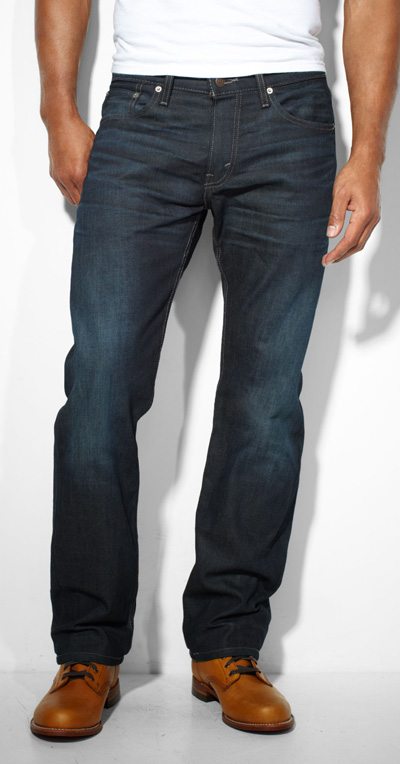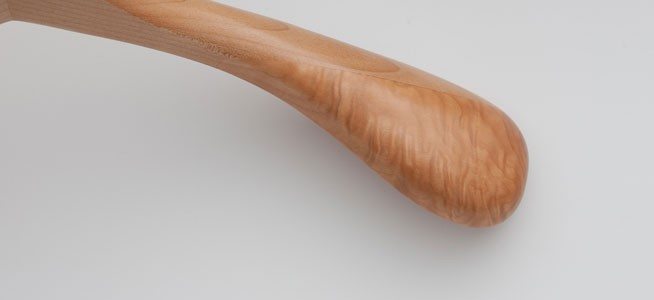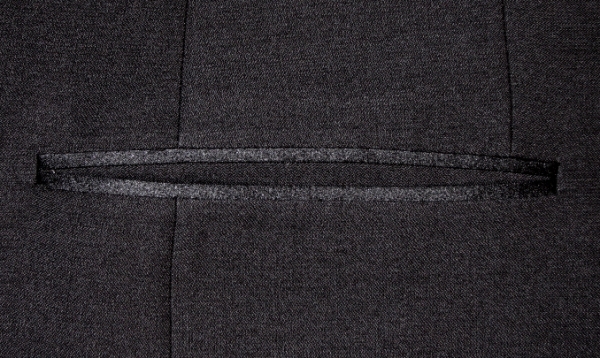Men’s Belt Basics: Buying a Belt
Very similar-looking belts sometimes vary widely in cost. The quality of the leather is one common factor: calfskin
is the most common material used for belts, and a good belt will have a
soft, supple leather. Flex the belt to make sure it hasn’t turned
brittle or started to crack. Another good test of leather is to score
the back very lightly with your fingernail — if a faint line appears,
the leather is still soft and fresh. Old, hard leather will resist your
nail.
Construction is the other major factor affecting the price of a
belt. Look for small, tight stitching with no loose ends wherever the
leather has been sewn. Buckles attached with a snap on the back of the
belt can be changed out, while a buckle stitched in place is the only
one you can wear with the belt — some men may find the flexibility of a
snapped belt worth paying more for, especially in good leather. Belts
can be custom-cut at some leather goods stores.
Brand name will also play a factor, but means quite a bit less than
the other factors. Your belt is too small for most people to be able to
tell at a glance whether it’s designer or not. Spend the money on
quality instead.
Men’s Belt Basics: Belts and Jean Labels
Speaking of designer goods, some high-end jeans have a famous label
right between two of the belt loops. You may be tempted to leave the
belt off, so that the label can be displayed more prominently.
It’s not a great idea in general. Unbelted jeans, even expensive
ones, make you look like a slob. Choose a slim belt that lets part of
the label show and leave it to other people to notice your fantastic
style — or not. If they weren’t in the know you weren’t going to
impress them anyway, right?
Related post:
http://www.matthewaperry.com/
http://ctdtailor.blogspot.com/2013/05/natural-linen-custom-made
-jacketleisure.html
http://matthewaperry.blogspot.com/2013/05/how-to-manage-
striped-custom-tailored.html
http://bespokesuits123.blogspot.com/2013/05/touch-on-sharp-suit.html
Friday, May 31, 2013
Wednesday, May 22, 2013
Cotton is King Of The Men’s Clothing World
The world’s most important apparel fiber makes up over 50% of the fabric sold throughout the world to including men’s cotton suits, cotton dress shirts, hosiery, underwear, and just about every piece of casual wear to include jeans and sweatshirts.
The popularity of cotton is no accident. Cotton fiber has a long history with man, and it has endured because its unique properties make it ideal for clothing.
Cotton fabric is attractive, durable, comfortable, takes to dyes, and most importantly has proven itself to be a superior fiber for men’s clothing manufacturing.
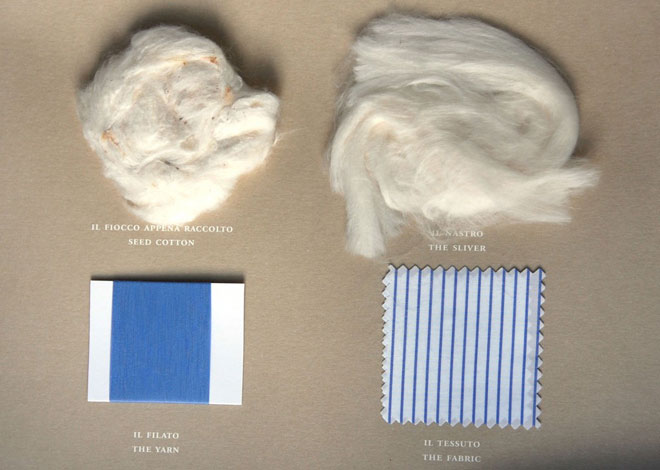
Physical Characteristics of Cotton Fiber
Cotton is divided into various groups depending on its physical characteristics; we will focus on two of the most important characteristics, the length of the cotton fiber and its fineness.
Cotton Fiber Length in Menswear
Cotton fibers vary in length considerably, from half an inch to 2 inches. Higher quality is often associated with longer length, and achieving this desired state is more expensive due the risk of a longer growth cycle and an increased demand on resources.
Long fibers make up only 3% of the worldwide output, and their use is typically reserved for high end shirt fabrics and other luxury.
A few varieties of this long fiber cotton used in shirt fabrics are American Pima, Egyptian, and Sea Island Cottons.
Cotton Fiber Fineness in Menswear
Cotton fiber fineness (the fiber’s diameter) is the second important quality of this king of fabrics.
High end fabric producers look to weed out irregularities and immature cotton fibers – these latter tend to be 20% thinner than mature fibers and can lead to early wear in shirtings fabrics due tot he fact they are less durable. Between length and fineness, even a bale of quality cotton can lose a large percentage of it’s fibers to QC. Thus the cost of high end cotton used in quality mens clothing can rises substantially.
Suit shop:http://www.matthewaperry.com/
Tuesday, May 21, 2013
How Far Up to Roll Your Sleeves
You’ll notice there’s no measurements in inches or centimeters on either of our methods. That’s because how far to roll the sleeves is up to you — with some caveats.
- Above the elbow is a more practical place to keep the sleeves if you’re actually working with your hands. Aesthetically though, it violates the “rule of thirds” and never looks quite as stylish as leaving the rolled sleeve a bit below the elbow. Also, if you have a loose cuff or a lot of sleeve fabric it can start to look odd as more and more fabric gets bunched up around your elbow ruining the line of your bicep. Stick to thin, tightly-fitted shirts if you’re rolling your sleeves high.
- Below the elbow is a less practical, more stylish option. It’s good in situations where you’re deliberately trying to look relaxed, and works great with the . You may need to roll the turned-back fabric over on itself a few more times to keep it tight on your forearms (unless you have very thick arms), which will thin the finished band of cloth out some.
http://ausuit.blogspot.com/2013/05/white-pinstripe-light-grey-suit.html http://matthewaperrysuits.blogspot.com/2013/05/the-adventures-of-gentleman.html http://fashionmansuits.blogspot.com/2013/05/vengeance-of-elegant-gentlemens-shirts.html
Monday, May 20, 2013
What Bond Never Wears
Men renting a tuxedo (and there’s nothing wrong with renting, so long as you’re careful) need to be particularly wary of anything that crosses the line from “black tie” to “costuming,” as more and more rental tuxes do these days:
• Colors should be entirely absent. A classic black tie ensemble is black or midnight blue with a simple white shirt.
• Shirts are plain white with studs or mother of pearl buttons. Collars are either point or wing. Do not try to introduce color here or bring in patterns. It’s not creative – it’s hideous.
• No colored lapels, vests, or cummerbunds. Yes, we said it before, but it bears repeating. These are not black tie elements. They’re purely novelty items introduced to the rental tuxedo industry in the 1970s that sadly surface at every high school prom and most American weddings. If you have someone try to sell you this – run like the wind friend, run.

Sunday, May 19, 2013
My definition of dressing sharp
Dressing well does not mean wearing a custom 3- piece suit everywhere you go. It just means looking your best in whatever environment you are in.
Being a well-dressed man may mean having a well-fitted suit as opposed to something cheap and off the rack, or it might mean adding a blazer or tie when you could get away with just a dress shirt in a less formal work environment. It can be as easy as putting on a sweater or vest when you are out with friends and wearing nice loafers instead of tennis shoes.
You can look well-dressed in anything if you always make sure the men suits you wear fit properly. You can’t look good squeezed into something you bought five years and 20 pounds ago, even if it was a really nice piece of clothing. Just make sure you’ve got a good, consistent fit all around: long sleeve shirts should extend just to the wrist and hang reasonably close to the body. Pants should fit close to the body and “break” by resting lightly on the tops of your shoes. Jackets need to give your arms freedom of movement without pinching and to cover your bottom when you stand.
One of my favorite outfits to wear when meeting with a client, speaking to groups about my business, or meeting up with friends is a dress shirt, a tie and a buttoned vest paired with a nice pair of jeans. It works in business environments but also works in a more casual setting. For an “off-the-clock” look later in the day I even loosen the tie a bit.
Friday, May 17, 2013
Buy Jeans That Fit
Over the years denim has evolved into its own little world of terminology and numbers that you won’t see elsewhere in menswear.
Boot cut…..
….Low Rise….
….Slim Cut….
…..Loose Fit….
….High Rise….
For the casual shopper, these terms and inconsistencies gets frustrating fast.
Do you need a low-rise slim fit?
A high-rise relaxed fit? Bootcut, skinny, straight-leg?
And where do numbers come into it all?
It’s a mess!
But we’re here to help.
This guide gives a definition for all the major terms used to describe men’s denim trousers, as well as some hints on how to find the style that suits you best.
We’ll start with the easy part: finding your measurements.
Most jeans, unless you’re having them custom-made, will be sized by two measurements: waist and inseam.
In addition to the listed numbers, a third measurement is often used to determine how the jeans are described:
….Low Rise….
….Slim Cut….
…..Loose Fit….
….High Rise….
For the casual shopper, these terms and inconsistencies gets frustrating fast.
Do you need a low-rise slim fit?
A high-rise relaxed fit? Bootcut, skinny, straight-leg?
And where do numbers come into it all?
It’s a mess!
But we’re here to help.
This guide gives a definition for all the major terms used to describe men’s denim trousers, as well as some hints on how to find the style that suits you best.
We’ll start with the easy part: finding your measurements.
Most jeans, unless you’re having them custom-made, will be sized by two measurements: waist and inseam.
- The waist measurement is the circumference, in inches, of the waistband of the pants — that inch-thick or so horizontal strip of cloth around the top. Wrap a tape measure around yourself where you want the waistband to sit. That’s your “waist” measurement, even if you’re wearing your jeans down on your hips.
- The inseam measurement starts in the center of the crotch (you’ll see the point where four seams all intersect in a kind of a cross-shape) and runs down the inside of the leg to the cuff. To find yours, measure from the place where your legs join down to the floor, standing barefoot. That’s about the inseam you want.
In addition to the listed numbers, a third measurement is often used to determine how the jeans are described:
- Rise is not usually listed on the tag, but many companies use the rise measurement to distinguish between “cuts” or styles of jeans. It’s the measurement from the center of the crotch (again, that middle point where all the seams come together) up to the center of the waistband, where the button usually sits. You won’t see it on tags unless you’re buying very specialized denim, but it does have an effect on terminology.
Thursday, May 16, 2013
Styles of Waxed Cotton Jacket
The Slicker or Oilskin: The traditional fisherman’s coat falls to the mid-calves and has a wide, double-breasted front and an attached cape on the back. Most also include a hood that buttons beneath the chin. They are extremely protective, especially when paired with waders, but are heavy and not the most stylish choice.
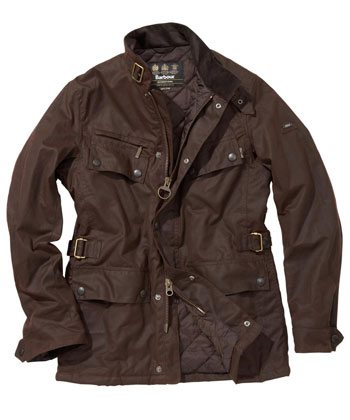 The Hunting or Hacking Jacket:
A thigh-length coat with a vent (slit) up the back to allow for riding.
Double- or single-breasted models are both common, going up to the neck
in either case and meeting a turndown collar. The collar is often done
in brown corduroy.
The Hunting or Hacking Jacket:
A thigh-length coat with a vent (slit) up the back to allow for riding.
Double- or single-breasted models are both common, going up to the neck
in either case and meeting a turndown collar. The collar is often done
in brown corduroy.The Field Jacket: A military style falling to just below the waist, with large front pockets and a built-in belt. Epaulets are common but not required.
The Moto Jacket: A tight-fitted, waist-length coat with a mandarin (non-turndown) collar and buttoning cuffs. Designed for motorcycle riding — Barbour in particular has a long-running association with cycling, dating back to the early 1930s.
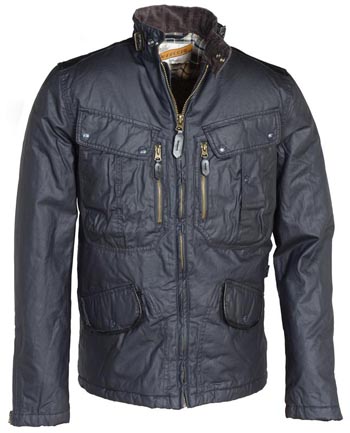 The Trench Coat:
The iconic military style: knee-length, built-in belt, epaulets and
storm flap. Waterproofed cotton and wool were the original materials for
the World War One-era trenchcoats that gave the style its name
The Trench Coat:
The iconic military style: knee-length, built-in belt, epaulets and
storm flap. Waterproofed cotton and wool were the original materials for
the World War One-era trenchcoats that gave the style its nameThere are many variations on all these basic styles. Hoods are quite common, as are all sorts of extra pockets designed for specific activities and items — shotgun shells, rolls of film, notebooks, and more.
Colors vary depending on brand and marketing, but earth tones are the most traditional. The original chemical process turned the cotton black or dark olive, which early manufacturers balanced with a brown corduroy collar, and all those are still quite common in modern waxed jacket styles.
In any cut or color, the sturdy, finished look of a waxed cotton jacket is a big selling point over more modern outdoors wear — unlike a brightly-colored plastic poncho, it looks like part of an outfit, rather than something draped over it. If you’re hiking the Appalachian Trail it probably doesn’t matter much; if you’re doing business in a big city you’ll be grateful for the added class.
Wednesday, May 15, 2013
Three-Season Flexibility
On the practical side your cardigan is also a more functional piece of clothing than a lot of menswear.
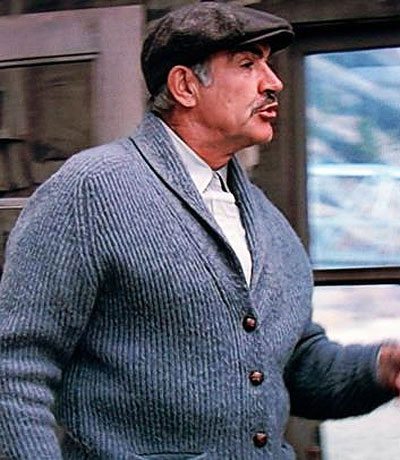 It’s what people sometimes refer to as “three-season” wear: useful year-round except for the hot summer months.
It’s what people sometimes refer to as “three-season” wear: useful year-round except for the hot summer months.On cool days that haven’t started to get really cold it can be an easily-removable outer layer.
When the temperature drops it can layer with shirts, ties, vest, jackets, and overcoats to be a thick layer of insulation.
The cardigan’s also a little looser than a sports jacket or blazer and takes a little more punishment.
It’s good on-the-go wear: easy to toss in the car or a backpack, forgiving of wrinkles, and big enough to wear over a dress shirt or flannel work shirt while still being small enough to wear under a blazer.
In a pinch it even makes a decent blanket — perfect for the gentleman whose date’s legs are getting chilled at a show or on a drive.
More info here: http://www.ausuit.com.au/
Monday, May 13, 2013
A Few Tips To Help You Effectively Incorporate A Pocket Square
Don’t get too matchy. Avoid matching exactly the color or especially the pattern of your pocket square to the suit, shirt or tie. The pocket square should provide a nice hint of color without looking like your outfit came off a department store shelf or you’re dressing for homecoming. A good rule of thumb for pocket squares: match the color to one color from your tie. This will add some pop to your outfit while still keeping the pocket square connected to the other articles you’ve chosen. The photo above is a great example of this technique in action (the picture below, not so much).
Try to avoid being too matchy – you’ll look like you’re in high school
(Photo courtesy of Etsy – Fantasy Vintage Bridal).
When in doubt, go with white. The white pocket square is the easiest and safest way to add a touch of class to an already fantastic suit. Anyone who’s watched an episode of Mad Men has seen how well Don Draper wears the white square. White pocket squares go with all suit and tie colors, styles and patterns. If you’re just experimenting with pocket squares, get a white linen or silk one and see how well it completes your suit.
Remember: the white pocket square complements any men suits
(Photo courtesy of SuitSupply).
Use it as a tie substitute. If you’re attending an event that requires you to dress up but you’re afraid a tie will be too much, then simply add a pocket square to a casual sport coat. The pocket square will add color and variety to your outfit, but won’t make you seem as stuffy as a tie might.
Related articles:
http://bespokesuits123.blogspot.com/2013/05/touch-on-sharp-suit.html http://www.topmensuit.com/index.php/classifications-italian-suits-2/ http://www.tailoredcustomsuits.com/index.php/my-struggles-shopping- for-pants/
Thursday, May 9, 2013
Bespoke Suits In The Wild Has Become a Habit
In the last few weeks, I have been happily spotting a few gentlemen in Paris whose accoutrement was particularly well assembled.
I must admit that spotting bespoke suits in the wild has become a habit, borderlining obsession. Nevertheless, even in the best weeks, I rarely see more than 4 or 5 men in bespoke… and I can assure you that I probably don’t miss that many. Indeed, telling a pagoda shoulder from a spalla con rollino, or recognizing worked button holes and perfectly adjusted double breasted jackets has become second nature to yours truly.
Last week, in one single day (!), I ran into two gents wearing very beautiful bespoke suits. Although I immediately recognized them as Neapolitan (the shoulders were easily identifiable to anyone with the slightest awareness on the subject), I was unable to tell, to my greatest dismay, the workshop where they had been made. The men wearing the suits (who had spotted the shoulder construction of my Cifonelli’s DB jacket in a nice 130′s Holland And Sherry glen plaid), revealed that their magnificent suits had been made by labels which PG is following from a distance, namely Antonio Panico and Gennaro Solito.
Both Neapolitan tailors make high tradition suits. While Panico clearly favours a decidedly natural shoulder construction (sloping shoulder), Solito’s are predominantly con rollino (slightly more structured Neapolitan shoulder with puckering). Personally, I am much keener on Panico’s work, although it’s only a question of taste, as Solito’s work is of equally high quality.
Here are a few images of both. Antonio Panico (who insiders know was the star cutter for Rubinacci in the 90s, before opening his own workshop), despite his old age, remains a paragon of elegance and style, as shown on the following photo (from last june’s Men’s ex).



You will also enjoy a preview of Solito’s production, an excellent workshop, including a typical example of the spalla con rollino (second images), so treasured by the label.


In the next few months, we will pay very close attention to the beautiful work of both.
Naples will always be Naples…
Related articles:
http://matthewaperrysuits.blogspot.com/2013/05/the-adventures-of- gentleman.html http://fashionmansuits.blogspot.com/2013/05/vengeance-of- elegant-gentlemens-shirts.html
http://mansuits123.blogspot.com/2013/05/natural-shoulder.html
I must admit that spotting bespoke suits in the wild has become a habit, borderlining obsession. Nevertheless, even in the best weeks, I rarely see more than 4 or 5 men in bespoke… and I can assure you that I probably don’t miss that many. Indeed, telling a pagoda shoulder from a spalla con rollino, or recognizing worked button holes and perfectly adjusted double breasted jackets has become second nature to yours truly.
Last week, in one single day (!), I ran into two gents wearing very beautiful bespoke suits. Although I immediately recognized them as Neapolitan (the shoulders were easily identifiable to anyone with the slightest awareness on the subject), I was unable to tell, to my greatest dismay, the workshop where they had been made. The men wearing the suits (who had spotted the shoulder construction of my Cifonelli’s DB jacket in a nice 130′s Holland And Sherry glen plaid), revealed that their magnificent suits had been made by labels which PG is following from a distance, namely Antonio Panico and Gennaro Solito.
Both Neapolitan tailors make high tradition suits. While Panico clearly favours a decidedly natural shoulder construction (sloping shoulder), Solito’s are predominantly con rollino (slightly more structured Neapolitan shoulder with puckering). Personally, I am much keener on Panico’s work, although it’s only a question of taste, as Solito’s work is of equally high quality.
Here are a few images of both. Antonio Panico (who insiders know was the star cutter for Rubinacci in the 90s, before opening his own workshop), despite his old age, remains a paragon of elegance and style, as shown on the following photo (from last june’s Men’s ex).



You will also enjoy a preview of Solito’s production, an excellent workshop, including a typical example of the spalla con rollino (second images), so treasured by the label.


In the next few months, we will pay very close attention to the beautiful work of both.
Naples will always be Naples…
Related articles:
http://matthewaperrysuits.blogspot.com/2013/05/the-adventures-of- gentleman.html http://fashionmansuits.blogspot.com/2013/05/vengeance-of- elegant-gentlemens-shirts.html
http://mansuits123.blogspot.com/2013/05/natural-shoulder.html
Wednesday, May 8, 2013
An Institution Of Masculine Elegance From Across The Pond
Today, let us turn the spotlight on the very excellent manufacturer
Oxxford (which, contrary to what its name might suggest, was not
established in Chicago) who we believe most likely represents the best
in classical masculine elegance across the Atlantic.
This article is also an opportunity to mention that in the last few years, the United States have been surprising, in some aspects of masculine style, those who once believed that elegance vanished outside of the England-Italy-France trifecta. Indeed, Paul Stuart’s affordable ready-to-wear (particularly the Phineas Cole collection), Ralph Lauren’s (very) high end ready-to-wear Purple Label and, more recently, Manolo Costa’s bespoke have all been proving the naysayers wrong with the high quality of lines and assembly found in their collections and other realizations.
Comes in Oxxford.
Established in 1916 by the Weinberg brothers, this honorable institution of American elegance continues to leave its mark away from the trends while resisting the sirens of globalization. For almost one hundred years, it has been making garments of the most utter quality made exclusively by hand in its historic manufacture in Chicago.
Again this year, Oxxford offers a very classy Fall/Winter collection with quality textiles and immaculate lines. Here are a few examples.








Related Articles:
http://mansuits123.blogspot.com/2013/05/bespoke-suit-by-yoshimi- hasegawa.html http://www.customtailoredsuit.com.au/index.php/return-savile-row/ http://www.topmensuit.com/index.php/history-repeating/ http://www.customtailoredsuit.com.au/index.php/return-savile-row/
This article is also an opportunity to mention that in the last few years, the United States have been surprising, in some aspects of masculine style, those who once believed that elegance vanished outside of the England-Italy-France trifecta. Indeed, Paul Stuart’s affordable ready-to-wear (particularly the Phineas Cole collection), Ralph Lauren’s (very) high end ready-to-wear Purple Label and, more recently, Manolo Costa’s bespoke have all been proving the naysayers wrong with the high quality of lines and assembly found in their collections and other realizations.
Comes in Oxxford.
Established in 1916 by the Weinberg brothers, this honorable institution of American elegance continues to leave its mark away from the trends while resisting the sirens of globalization. For almost one hundred years, it has been making garments of the most utter quality made exclusively by hand in its historic manufacture in Chicago.
Again this year, Oxxford offers a very classy Fall/Winter collection with quality textiles and immaculate lines. Here are a few examples.








Related Articles:
http://mansuits123.blogspot.com/2013/05/bespoke-suit-by-yoshimi- hasegawa.html http://www.customtailoredsuit.com.au/index.php/return-savile-row/ http://www.topmensuit.com/index.php/history-repeating/ http://www.customtailoredsuit.com.au/index.php/return-savile-row/
Tuesday, May 7, 2013
What is a Gentleman?
His benefits may be considered as parallel to what are called comforts or conveniences in arrangements of a personal nature: like an easy chair or a good fire, which do their part in dispelling cold and fatigue, though nature provides both means of rest and animal heat without them.
The true gentleman in like manner carefully avoids whatever may cause ajar or a jolt in the minds of those with whom he is cast; — all clashing of opinion, or collision of feeling, all restraint, or suspicion, or gloom, or resentment; his great concern being to make every one at their case and at home.
He has his eyes on all his company; he is tender towards the bashful, gentle towards the distant, and merciful towards the absurd; he can recollect to whom he is speaking; he guards against unseasonable allusions, or topics which may irritate; he is seldom prominent in conversation, and never wearisome. He makes light of favours while he does them, and seems to be receiving when he is conferring.
He never speaks of himself except when compelled, never defends himself by a mere retort, he has no ears for slander or gossip, is scrupulous in imputing motives to those who interfere with him, and interprets everything for the best.
He is never mean or little in his disputes, never takes unfair advantage, never mistakes personalities or sharp sayings for arguments, or insinuates evil which he dare not say out. From a long-sighted prudence, he observes the maxim of the ancient sage, that we should ever conduct ourselves towards our enemy as if he were one day to be our friend.
He has too much good sense to be affronted at insults, he is too well employed to remember injuries, and too indolent to bear malice. He is patient, forbearing, and resigned, on philosophical principles; he submits to pain, because it is inevitable, to bereavement, because it is irreparable, and to death, because it is his destiny. If he engages in controversy of any kind, his disciplined intellect preserves him from the blunder.”
More articles:
Monday, May 6, 2013
THE MALE ELEGANCE CLIMATE

John Hamm dressed for the role of a doctor in 1917 set during the Russian Revolution and based on the stories of Mikhail Bulgakov. Could this look now be considered “irresistible“?
The male elegance climate appears to be simmering to a boil lately (compared to a mere five years ago). While we are seeing a boom in men dressing well with a growing penchant for style and quality, at the same time we notice a collapse in the frequency of spotting the quintessential middle management man with scuffed-up shoes and a dilapidated leather belt with belt-hole notches shaped like inverted amebas (of which he seems oddly proud to announce that his belt notches chronicle his weight loss and gain history since 1990… hence you deduce that his belt must be around 13 years old).
These days, it is more likely for a man to feel good about having immaculately polished shoes and to find satisfaction in knowing that a belt is rarely needed with a suit in the first place, since the complete body line of a man looks much better when he opts for trousers designed for no belt, thus avoiding the “cutting of the man in half” visual effect that a belt causes.

This man understands that wearing a belt with a suit can be passé and cut the flow of the total line of a man.
Yet even if men are speeding towards sartorial excellence at an alarming rate, we continue to see the occasional breed of the sartorial counter culture set fanning the embers of the spirit of the 1980s “casual Friday movement”, perhaps most by those who feel trapped as time-watchers living for 5 o’clock and for the promise of anoher weekend—leaving us with the impression of a lost ability to feel intrigue for any day except Friday, Saturday and Sunday…with even churches replacing dress standards with the come as you are mindset.
France (even with its obvious population of sartorial-gifted men and women) gives us a more direct example of a diminishing regard for the work week by introducing “Half-Day Fridays “, or more specifically a reduction of the hours in the workweek from 39 to 35 hours, since the year 2000. At this rate, in the year 2052, we can project an introduction of the two hour workday–with potential daily perks such as Tie-Less Thursdays, Facebook Wednesdays, No Need to Tuck Your Shirt In Tuesdays, and Don’t Bother to Show Up Mondays.
This passive attitude towards how we present ourselves creates a piggy-back effect that biases these same time-watchers towards the belief that the reason dressing casually is better is because it is easier. And, once it is perceived that the daily goal is to make things easier, then the possibility of sartorial glory is lost. And, if a sartorial atheist believes that Monday through Thursday constitute corporate enslavement, forced dress-codes, and a general sense of misery, then we accept that we are unlikely to see a glowing sartorial result within this cultural realm.
However, the incredible point that may be easy to overlook, is that the sartorially-inclined man can use Casual Friday to his advantage as an optimal opportunity to come to work in business-only attire, which causes him be noticed in a way that helps communicate his own unique persona while at the same time, nurturing career advancement potential and boosting the chance for success in his social endeavors.

Not foregoing the necktie on Casual Friday sets this man apart from the others.
Although many may consider disregarding Casual Fridays to be somewhat hardcore, in actuality, dressing well is a moderate gesture that pays great dividends.“Dress for the job above yours…and rethink casual Friday. Business Insider, 2011″
Related article:
http://bespokesuits123.blogspot.com/2013/05/a-shirt-has-three- standard-designs.html
http://mansuits123.blogspot.com/2013/05/bespoke-suit-by-yoshimi- hasegawa.html
Sunday, May 5, 2013
BRITISH TAILORING — Straight to the Point
The shoulder line is key on a bespoke suit. Once you have a strong understanding of that, the rest flows from there. ~Ozwald Boateng



According to AW London / Savile Row, there are three British shoulder construction standards:
A Classic British Suit – The Shoulder
1. The shoulders should neither be too narrow or to wide, but slightly hug the shoulder
2. Shoulders should be padded to add structure, rather than bulk
3. There should be a sharp 90 degree right angle between the shoulder and the sleeve of the suit
British tailors have historically used just enough padding to follow the natural shoulder line, with a precision fit that could be suited for the military. Some tailors will barely extend the natural shoulder line so that the sleeve will hang straighter.
related post:
http://mansuits123.blogspot.com/2013/05/italianfrench- tailoring-expressive-and.html
Friday, May 3, 2013
Is Your Favorite Suit Being Destroyed Right Now In Your Closet
Think about it.
Your jackets spend more time in your closet than they do on your shoulders.
And what are they resting on – for days if not months & years?
Thin, cheap, wire hangers that are NOTHING like your shoulders?
The fact is wire hangers cause puckered shoulders, re-shape hand-padded expensive jacket shoulder negatively, and ultimately ruin your clothes right in your own closet.
Don’t ruin great clothes with cheap hangers.
One size doesn’t fit all when it comes to your clothes, and the same is true when it comes to your hangers.
This article provides detail guidance on the new standards for sizing the perfect wooden garment hanger.
“Alan Katzman of Alan Couture, a bespoke clothier in Manhattan whose suits range from $5,000 to $30,000… calls quality hangers a must. Unlike the dreaded wire versions, hangers with wide shoulders and a broader overall design prolong a garment’s life by preventing sagging or stretching.”Ordinary hangers just hang your clothes. They do nothing more. Examples are free wooden hangers, wire and cardboard hangers from dry cleaners, and plastic hangers, and they can be found in many ordinary closets.
No Wire Hangers!
Nov 16, 2008, Wall Street Journal
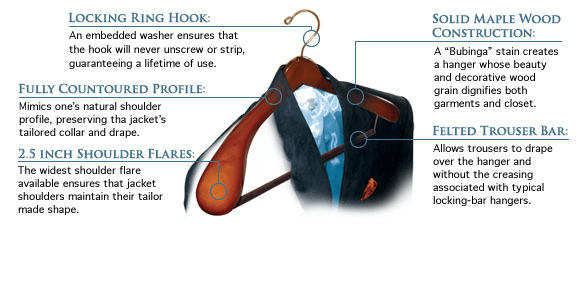 Properly
made wooden hangers, on the other hand, are deliberately crafted from
premium woods to protect and extend the life of your clothing.
Properly
made wooden hangers, on the other hand, are deliberately crafted from
premium woods to protect and extend the life of your clothing. They provide opulent shoulder support, are correctly sized, and do not damage your clothes.
Over the life of your wardrobe, they can save you thousands of dollars in ruined garments (think about the number of times you’ve thrown away a shirt because of shoulder dimples or a suit because it became limp).
Let’s Talk Hanger Styles
The style of a hanger is the first thing to consider when selecting your hanger. Different hangers are designed for different purposes.
I make seven different styles designed just for men, plus another nine totally different styles for women. Men and women have dramatically different wardrobes, and the same is true for their hangers. A premium wooden hanger is, by design, gender specific.
The following is a list and brief description of different styles of men’s hangers and their use:
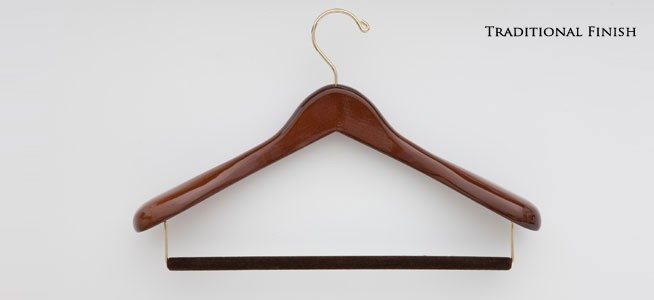 Suit Hangers – a proper suit hanger
is used to hang matching jacket and trouser sets. The hanger should
offer opulent support to protect the delicate, tailored shoulder
construction and drape. They should be fully contoured and have a large
shoulder flare to optimize shoulder support. The trouser bar should be
flocked or felted in order to prevent the creasing that ordinary locking
bars can cause. The width is also important; in order to offer optimal
support, the suit hanger should extend up to but not beyond the point
where the shoulder meets the sleeve. This is especially important for
gentlemen with broad shoulders, as the weight of a large jacket
distributed on a skinny hanger will almost immediately destroy its
drape.
Suit Hangers – a proper suit hanger
is used to hang matching jacket and trouser sets. The hanger should
offer opulent support to protect the delicate, tailored shoulder
construction and drape. They should be fully contoured and have a large
shoulder flare to optimize shoulder support. The trouser bar should be
flocked or felted in order to prevent the creasing that ordinary locking
bars can cause. The width is also important; in order to offer optimal
support, the suit hanger should extend up to but not beyond the point
where the shoulder meets the sleeve. This is especially important for
gentlemen with broad shoulders, as the weight of a large jacket
distributed on a skinny hanger will almost immediately destroy its
drape.
- Jacket Hangers – A proper jacket hanger should contain all of the same characteristics of a suit hanger (detailed above) but without the trouser bar. Jacket hangers are used for sports coats that would not have matching trousers and guest coat closets.
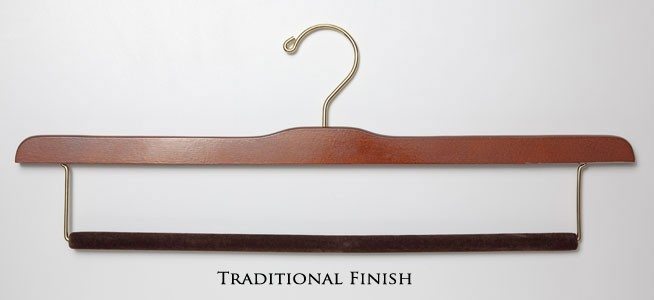 Trouser Hangers – Trouser hangers
are an essential part of any well-appointed closet and are only used
for hanging trousers. Because of their specific application, they save
room relative to using old suit hangers. The most important criteria for
a wooden trouser hanger is whether it creases trousers. Locking bars,
although very common, actually damage the fabric of most trousers over
time and lead to creasing across the thigh, which can result in
embarrassing creases across the trousers when pulled out of the closet.
Trouser hangers are not contoured.
Trouser Hangers – Trouser hangers
are an essential part of any well-appointed closet and are only used
for hanging trousers. Because of their specific application, they save
room relative to using old suit hangers. The most important criteria for
a wooden trouser hanger is whether it creases trousers. Locking bars,
although very common, actually damage the fabric of most trousers over
time and lead to creasing across the thigh, which can result in
embarrassing creases across the trousers when pulled out of the closet.
Trouser hangers are not contoured.
- Locking Bars – A wooden bar locks the trousers between a metal wire. This mechanism is BAD, as they cause creasing across trousers and can damage premium wools (like Super 100′s). This is the most common and inexpensive type of trouser bar and can be found on most department store hangers.
- Felted Trouser Bar – The trouser bar is flocked or felted with a material whose texture “grips” trousers. Trousers drape over the bar and no pressure is applied (as with a locking bar), thereby preventing creasing. This is the BEST style and can only be found on premium wooden suit hangers.
- Clamping Trouser Bar – two planks of wood with felted interiors clamp trousers at their cuff and hang them vertically upside. This style is popular but demands a lot of vertical closet space. The weight of the trousers “pull” wrinkles out over time as the trousers hang. Can be found on premium wooden suit hangers, although they increase their cost significantly.
- Clip Hangers – use two independent clips to secure the trouser. These are generally discouraged for finer wool, cotton, or linen trousers because the force of the clip can damage the fabric. However, they are totally acceptable for hanging denim jeans or shorts.
- Shirt Hangers – a man’s shirt hanger should extend all the way to the edge of the shoulder. If a shirt hanger is too narrow (width), puckering or dimpling occurs. It should also be thick enough to offer support, but not so thick that closet space is unnecessarily consumed. Premium wooden shirt hangers are especially important for loosely-knit fabrics, such as cotton and cashmere shirts. Shirt hangers are not contoured.
- Sweater Han
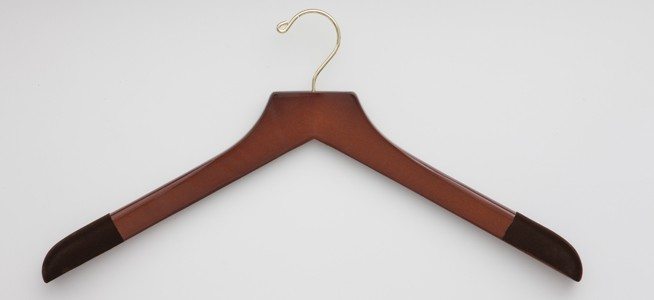 ger
– Most people fold their sweaters — not because folding is necessarily
better, but because most ordinary hangers are very quick to destroy
sweaters. This is why The Hanger Project developed a sweater
specifically sweaters and soft knits. The moderate shoulder flare, which
is flocked to help grip the garment, controls the sweater and prevents
it from sliding down the hanger. This prevents both stretching and
shoulder puckering.
ger
– Most people fold their sweaters — not because folding is necessarily
better, but because most ordinary hangers are very quick to destroy
sweaters. This is why The Hanger Project developed a sweater
specifically sweaters and soft knits. The moderate shoulder flare, which
is flocked to help grip the garment, controls the sweater and prevents
it from sliding down the hanger. This prevents both stretching and
shoulder puckering.
The width of a hanger is the most overlooked but critical characteristic of a proper hanger.
One size doesn’t fit all when it comes to your clothing, and the same should be true when it comes to your hangers. Considering that your garments will spend more time in your closet over the lifetime than on your shoulders, it is easy to understand why this characteristic is so important.
The sizing principle is the same for both suits and shirts: the hanger should extend all the way to–but not beyond–the point where the shoulder meets the sleeve. The most accurate method of sizing your hanger is to measure directly across the back (the point-to-point measurement).
My company makes suit hangers in four widths: 15.5″, 17.0″, 18.5″, and 20.0″. A 20.0″ suit hanger is an exceptionally large suit hanger perfect for professional athletes and other gentlemen with particularly broad shoulders, while the smaller hanger is aimed for the smaller man who is tired of over sized hangers blowing out the shoulders on his expensive suit jackets.
As for wooden shirt hangers, you’ll often find them in lengths of 17.0″, 19.0″, and 21.0″. Choose the size that is closest to the width of your shirt. It is okay for your shirt hanger to extend slightly beyond the shoulder. With the right luxury shirt hanger, you will be able to almost eliminate the annoying shirt puckering that often plagues closets.
Hanger Girth
The GIRTH of a hanger, or it’s thickness, is particularly important at its ends. I make a suit hanger with a 2.5″ Shoulder Flares distributes the weight of a jacket over a surface area 5x larger than average. This, in turn, ensures that the drape of the jacket is protected.
I hope you found this article useful – if you have any wisdom or stories to share I’d love to hear from you in the comments below.
More info:
http://mansuits123.blogspot.com/2013/05/why-are-flannel- trousers-so-hard-to-buy.html
Thursday, May 2, 2013
A Man’s Financial and Time Resources
On the subject of unalterable realities, a man always has to keep his available resources in mind. A custom-tailored suit is a great piece of clothing to have — and an expensive one. Men on a limited budget need to pick and choose their clothes carefully. Suits and jackets can be worn with different styles of shirt beneath them, making them a flexible option for a wardrobe. And while unusually large or small men may need their clothing tailored from scratch, most men can find off-the-rack or even thrift store clothing that will fit with some small, affordable adjustments.
Keeping the wardrobe in good shape helps
each piece last longer and lets a man save for new clothing. Shoes
should be kept well-shined, which looks professional as well as
protecting them from water and dirt. Suits and jackets can get by with
only infrequent dry-cleaning (a process that shortens the fabric’s
lifespan) if they are brushed and hung up on a shoulder-shaped hanger as
soon as they are removed. Shirts keep their collar shape when
well-pressed, and with good ironing require little or no spray starch,
another process that weakens the clothing’s fibers.
Wednesday, May 1, 2013
Know About Suit Pockets
If you polled 100 on the street and asked them how many different
types of suit pockets there are, you will likely get 15 different
answers (if the guys don’t simply roll their eyes and walk away). These
men will likely be surprised to hear that there are 5 different pocket
types commonly found in men’s suits, and we will profile in a little bit
of detail below.
The besom pocket (or welt pocket or jetted pocket as it is also known), looks like a slit cut in the suit fabric. The two sides of the pocket that meet are called the welts, hence its alternative moniker. This pocket is considered quite formal and is commonly found on suits and tuxedos.
The flap pocket is a modified besom pocket that has a flap of fabric covering the bottom welt. Some men will tuck the flap into the pocket giving the suit the illusion of having a besom pocket (this also gives the wearer flexibility with his suit). As with the besom pocket, this is one of the more formal pockets and is found on suits and tuxedos as well.
The single welt pocket is similar to a besom pocket but doesn’t have the upper welt; this makes the pocket more accessible for the wearer. The single welt pocket is commonly seen on vests for three piece suits.
The patch pocket is more casual than the three previous pockets. The pocket is sewn onto the fabric of the suit as opposed to being cut into the fabric. The patch pocket is found on casual sport coats and not on formal attire.
The last and least common pocket is the bellows pocket. It commonly appears as the pocket found on cargo pants. This pocket traces its roots back to the jacket’s hunting and sport origins. The folds in the pocket allow it to expand when filled to capacity. As with the patch pocket, this is a very casual option and should be worn for less formal occasions.
While we are talking about pockets let’s quickly address a common question men have when purchasing a suit: “Why are the pockets sewn shut on this suit?” This is called the basting stitch or basting thread and is found in various pockets and locations on new suits. Initially, the stitch is used to keep pockets and vents closed and lined up while the suit is being constructed. Once finished, the thread is kept on and helps keep the pocket closed and the suit flat during transportation, display, and fittings. Once purchased, the thread has serves no further purpose and can be carefully removed. Whether you take it out though is up to personal preference; there’s no set style rule that says your pockets must be basting stitch free!
http://bespokesuits123.blogspot.com/2013/05/suit-pockets.html
The besom pocket (or welt pocket or jetted pocket as it is also known), looks like a slit cut in the suit fabric. The two sides of the pocket that meet are called the welts, hence its alternative moniker. This pocket is considered quite formal and is commonly found on suits and tuxedos.
The flap pocket is a modified besom pocket that has a flap of fabric covering the bottom welt. Some men will tuck the flap into the pocket giving the suit the illusion of having a besom pocket (this also gives the wearer flexibility with his suit). As with the besom pocket, this is one of the more formal pockets and is found on suits and tuxedos as well.
The single welt pocket is similar to a besom pocket but doesn’t have the upper welt; this makes the pocket more accessible for the wearer. The single welt pocket is commonly seen on vests for three piece suits.
The patch pocket is more casual than the three previous pockets. The pocket is sewn onto the fabric of the suit as opposed to being cut into the fabric. The patch pocket is found on casual sport coats and not on formal attire.
The last and least common pocket is the bellows pocket. It commonly appears as the pocket found on cargo pants. This pocket traces its roots back to the jacket’s hunting and sport origins. The folds in the pocket allow it to expand when filled to capacity. As with the patch pocket, this is a very casual option and should be worn for less formal occasions.
While we are talking about pockets let’s quickly address a common question men have when purchasing a suit: “Why are the pockets sewn shut on this suit?” This is called the basting stitch or basting thread and is found in various pockets and locations on new suits. Initially, the stitch is used to keep pockets and vents closed and lined up while the suit is being constructed. Once finished, the thread is kept on and helps keep the pocket closed and the suit flat during transportation, display, and fittings. Once purchased, the thread has serves no further purpose and can be carefully removed. Whether you take it out though is up to personal preference; there’s no set style rule that says your pockets must be basting stitch free!
http://bespokesuits123.blogspot.com/2013/05/suit-pockets.html
Subscribe to:
Posts (Atom)



